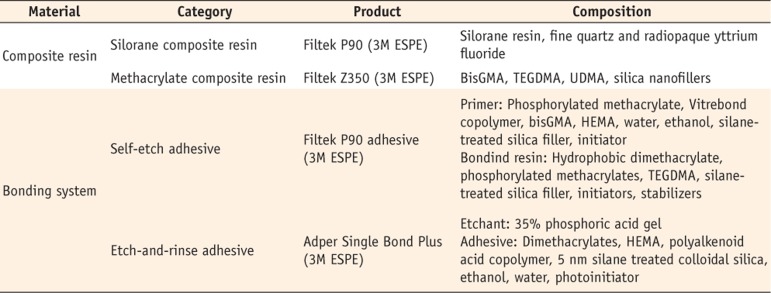1. Mohammadi Z. Antibiotics as intracanal medicaments: a review. J Calif Dent Assoc. 2009; 37:98–108. PMID:
19489526.
2. Ordinola-Zapata R, Bramante CM, Minotti PG, Cavenago BC, Garcia RB, Bernardineli N, Jaramillo DE, Hungaro Duarte MA. Antimicrobial activity of triantibiotic paste, 2% chlorhexidine gel, and calcium hydroxide on an intraoral-infected dentin biofilm model. J Endod. 2013; 39:115–118. PMID:
23228269.

3. Windley W 3rd, Teixeira F, Levin L, Sigurdsson A, Trope M. Disinfection of immature teeth with a triple antibiotic paste. J Endod. 2005; 31:439–443. PMID:
15917683.
4. Yurdagüven H, Tanalp J, Toydemir B, Mohseni K, Soyman M, Bayirli G. The effect of endodontic irrigants on the microtensile bond strength of dentin adhesives. J Endod. 2009; 35:1259–1263. PMID:
19720227.

5. Yassen GH, Chu TM, Eckert G, Platt JA. Effect of medicaments used in endodontic regeneration technique on the chemical structure of human immature radicular dentin: an
in vitro study. J Endod. 2013; 39:269–273. PMID:
23321244.
6. Schwartz RS, Fransman R. Adhesive dentistry and endodontics: materials, clinical strategies and procedures for restoration of access cavities: a review. J Endod. 2005; 31:151–165. PMID:
15735460.

7. Van Meerbeek B, De Munck J, Yoshida Y, Inoue S, Vargas M, Vijay P, Van Landuyt K, Lambrechts P, Vanherle G. Buonocore memorial lecture. Adhesion to enamel and dentin: current status and future challenges. Oper Dent. 2003; 28:215–235. PMID:
12760693.
8. Sato I, Ando-Kurihara N, Kota K, Iwaku M, Hoshino E. Sterilization of infected root-canal dentine by topical application of a mixture of ciprofloxacin, metronidazole and minocycline
in situ. Int Endod J. 1996; 29:118–124. PMID:
9206435.
9. Van Meerbeek B, Yoshihara K, Yoshida Y, Mine A, De Munck J, Van Landuyt KL. State of the art of self-etch adhesives. Dent Mater. 2011; 27:17–28. PMID:
21109301.

10. Tjäderhne L, Larjava H, Sorsa T, Uitto VJ, Larmas M, Salo T. The activation and function of host matrix metalloproteinases in dentin matrix breakdown in caries lesions. J Dent Res. 1998; 77:1622–1629. PMID:
9719036.

11. Manso AP, Marquezini L Jr, Silva SM, Pashley DH, Tay FR, Carvalho RM. Stability of wet versus dry bonding with different solvent-based adhesives. Dent Mater. 2008; 24:476–482. PMID:
17675145.

12. Maruyama H, Aoki A, Sasaki KM, Takasaki AA, Iwasaki K, Ichinose S, Oda S, Ishikawa I, Izumi Y. The effect of chemical and/or mechanical conditioning on the Er:YAG laser-treated root cementum: analysis of surface morphology and periodontal ligament fibroblast attachment. Lasers Surg Med. 2008; 40:211–222. PMID:
18366073.

13. Wattanawongpitak N, Nakajima M, Ikeda M, Foxton RM, Tagami J. Microtensile bond strength of etch-and-rinse and self-etching adhesives to intrapulpal dentin after endodontic irrigation and setting of root canal sealer. J Adhes Dent. 2009; 11:57–64. PMID:
19343928.
14. Santana FR, Pereira JC, Pereira CA, Fernandes Neto AJ, Soares CJ. Influence of method and period of storage on the microtensile bond strength of indirect composite resin restorations to dentine. Braz Oral Res. 2008; 22:352–357. PMID:
19148392.

15. Ozer F, Unlü N, Sengun A. Influence of dentinal regions on bond strengths of different adhesive systems. J Oral Rehabil. 2003; 30:659–663. PMID:
12787465.
16. Pashley DH, Ciucchi B, Sano H, Carvalho RM, Russell CM. Bond strength versus dentine structure: a modelling approach. Arch Oral Biol. 1995; 40:1109–1118. PMID:
8850649.

17. Hashimoto M, Ohno H, Kaga M, Sano H, Tay FR, Oguchi H, Araki Y, Kubota M. Over-etching effects on microtensile bond strength and failure patterns for two dentin bonding systems. J Dent. 2002; 30:99–105. PMID:
12381409.

18. Sano H, Shono T, Sonoda H, Takatsu T, Ciucchi B, Carvalho R, Pashley DH. Relationship between surface area for adhesion and tensile bond strength-evaluation of a micro-tensile bond test. Dent Mater. 1994; 10:236–240. PMID:
7664990.
19. Heling I, Gorfil C, Slutzky H, Kopolovic K, Zalkind M, Slutzky-Goldberg I. Endodontic failure caused by inadequate restorative procedures: review and treatment recommendations. J Prosthet Dent. 2002; 87:674–678. PMID:
12131891.

20. Cecchin D, Farina AP, Galafassi D, Barbizam JV, Corona SA, Carlini-Júnior B. Influence of sodium hypochlorite and edta on the microtensile bond strength of a self-etching adhesive system. J Appl Oral Sci. 2010; 18:385–389. PMID:
20835574.

21. Tripathi KD. Essentials of Medical Pharmacology. 5th ed. New Delhi: Jaypee Brothers Medical;1985. p. 710.
22. Minabe M, Takeuchi K, Kumada H, Umemoto T. The effect of root conditioning with minocycline HCl in removing endotoxin from the roots of periodontally-involved teeth. J Periodontol. 1994; 65:387–392. PMID:
8046553.

23. Van Landuyt KL, Kanumilli P, De Munck J, Peumans M, Lambrechts P, Van Meerbeek B. Bond strength of a mild self-etch adhesive with and without prior acid-etching. J Dent. 2006; 34:77–85. PMID:
15979226.

24. Van Landuyt KL, Peumans M, De Munck J, Lambrechts P, Van Meerbeek B. Extension of a one-step self-etch adhesive into a multi-step adhesive. Dent Mater. 2006; 22:533–544. PMID:
16300826.

25. Schreiner RF, Chappell RP, Glaros AG, Eick JD. Microtensile testing of dentin adhesives. Dent Mater. 1998; 14:194–201. PMID:
10196796.

26. Nakabayashi N, Watanabe A, Arao T. A tensile test to facilitate identification of defects in dentine bonded specimens. J Dent. 1998; 26:379–385. PMID:
9611944.

27. Walter R, Miguez PA, Pereira PN. Microtensile bond strength of luting materials to coronal and root dentin. J Esthet Restor Dent. 2005; 17:165–171. PMID:
15996387.

28. Abo-Hamar SE. Effect of endodontic irrigation and dressing procedures on the shear bond strength of composite to coronal dentin. J Adv Res. 2013; 4:61–67. PMID:
25685402.








 PDF
PDF ePub
ePub Citation
Citation Print
Print




 XML Download
XML Download